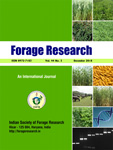NIVEDITHA K. DIVAKARAN AND USHA C. THOMAS
PG Scholar, Department of Agronomy, College of Agriculture, Vellayani, (Kerala) India
Professor(Agronomy) and Head, Instructional farm, College of Agriculture, Vellayani, (Kerala) India
*(e-mail : nivedithakdivakaran@gmail.com)
(Received: 10 December 2024; Accepted: 29 December 2024)
SUMMARY
The study entitled “Standardisation of nitrogen fertiliser dose and spacing in fodder oats at high ranges of Kerala” was undertaken during Rabi 2021-22 at Wayanad Eastern Plateau with the objective to find out the optimum nitrogen dose and spacing level for fodder oat cultivation. The experiment was done in randomized block design with nine treatments replicated thrice. Treatments consisted of two factors viz., row spacing (S) and nitrogen dose (N) at three levels each viz., s1 (15 cm), s2 (25 cm), s3 (35 cm) and n1 (60 kg N/ha), n2 (90 kg N/ha), n3 (120 kg N/ha) respectively. The results of the study revealed that, s3n3 (35 cm, 120 kg N/ha) recorded the tallest plant and a greater number of tillers/hill. In case of GFY (green fodder yield) and DFY (dry fodder yield), s1n3 recorded the highest yield GFY and DFY. Nitrogen dose n3(120 kg N/ha) recorded the highest chlorophyll content and crude protein content. Moreover, application of 120 kg/ha nitrogen at a spacing 15 cm had given the highest net income (Rs. 58645.92/ha) and BC ratio (1.87).
Key words: Chlorophyll, crude protein, fodder, minerals, palatability

